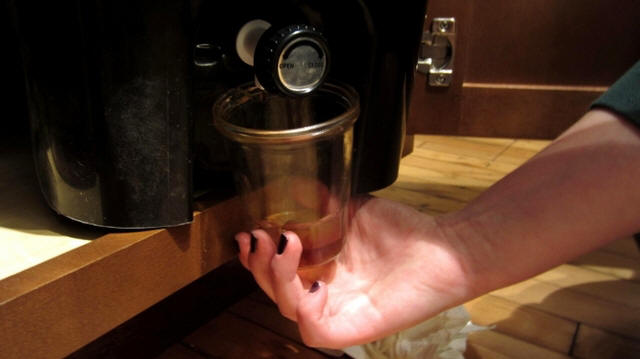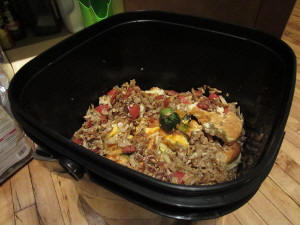Composting adventures: My cup runneth over
- October 12, 2012
- By Kerri Jansen
 Courtesy, Kerri Jansen
The "bokashi tea" that drains from the
compost bin can be used as fertilizer or drain cleaner.
Courtesy, Kerri Jansen
The "bokashi tea" that drains from the
compost bin can be used as fertilizer or drain cleaner.
For the next couple weeks, Waste & Recycling News reporter Kerri Jansen will be blogging about her experience with bokashi composting, a new method of composting developed in Japan and gaining popularity in the U.S. This is Part 3 of her story (read Part 1 and Part 2).
If you had walked into my kitchen at about 9:45 Wednesday night, you would have found me hunched over the cupboard under my kitchen sink, my hands and floor covered in a sticky-sweet, brownish liquid.
The liquid is called bokashi tea. It's produced when microbes break down the organic waste, and is reportedly chock-full of nutrients. I was attempting to drain it from a spigot near the bottom of the compost bin into a glass jar -- the instructions said to do this every few days.
What the instructions did not say was that the bokashi tea tends to splatter... all over me, my kitchen and the cat. This isn't necessarily a problem with bokashi composting, but likely a mechanical shortfall with the particular bin I ordered. Or perhaps a shortfall with my own gracefulness.
A few tablespoons of the liquid actually made it into the jar. Bokashi tea can be diluted and used as fertilizer, or used full-strength to clean out drains, according to the literature. I went with the former option, and dumped the solution on a potted tomato plant growing on my front porch. If the plant doesn't shrivel and die in the next few days, I will consider that proof the liquid isn't toxic.
 After about a week, my bokashi compost
bin is about half full, topped with a generous helping of
cabbage salad.
After about a week, my bokashi compost
bin is about half full, topped with a generous helping of
cabbage salad. I collected some stale biscuits and hot dog buns to balance out the moisture in the bin from the last layer. I also added dinner scraps -- pasta with tomato sauce and leftover cabbage salad that my roommate assured me was at one time delicious.
Despite shaking on a generous helping of bokashi bran, when I cracked the lid of the bin the next morning, the fumes that exited the bin were thoroughly rank. The bran is supposed to neutralize odors; apparently it was no match for moldering cabbage.
For comparison, I checked on a plastic container of food scraps I sealed on the first day of the project as a control experiment. There was no cabbage in that container, nor any bran; it smelled like rotting vegetables because that's exactly what it was. But the smell wasn't as offensive as the cabbage salad.
There was also mold in that container, something I haven't yet noticed in the bokashi compost bin.
So far, this composting project has been a bit rocky. I'll practice my spigot skills so my kitchen floor is spared another helping of bokashi tea. Next week I'll dig into the bin to see if the lower layers of scraps have started decomposing yet. I'm not sure what I'll find.
The Reckoning:
Percent of bin filled: 50%
Odor (1 = sunshine and daisies; 10 = putrid sludge): 6
Maintenance needed (1 = little to none; 10 = major hassle): 3
Friend/roommate cooperation (1 = polite tolerance; 10 = disowned forever): 2
![]()
w w w . w a s t e r e c y c l i n g n e w s . c o m
copyright 2012 by Crain Communications Inc. All rights reserved.